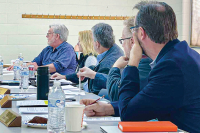‘Jack of all trades’ common in Appalachia
Here in the Smokies region “making do” isn’t a lost art. Most “country” men and women can still “get along” because they grew up doing so. And the “jack-of-all-trades” era isn’t ancient history — it lasted on mountain farms until not very many years ago.
When writing Our Southern Highlanders (1913), Horace Kephart recalled the years (1904-1907) when he resided on the Little Fork of the Sugar Fork of Hazel Creek in the Smokies: “In our primitive community there were no trades, no professions. Every man was his own farmer, blacksmith, gunsmith, carpenter, cobbler, miller and tinker. Someone in his family, or a near neighbor, served him as barber and dentist, and would make him a coffin when he died.”
There are two books in which the authors describe very clearly the “make do” lifestyles of the mountain past. The first is by Duane Oliver, who grew up on Hazel Creek. His Hazel Creek From Then Til Now (1989) contains a chapter titled “‘Won’t You Stay for Supper? We’re Having Leatherbritches, Corn Pone, Bear Meat, Gritted Bread, Poke Sallit and Sourwood Honey.’ ‘I Believe I Will, I’m Partial to Poke Salit.’”
Oliver opens that chapter with a paean to mountain women: “The pioneer women of Hazel Creek had her hands full. Some of her activities, such as hoeing, picking berries, gathering nuts and herbs, and drying and pickling, were seasonal. Other chores such as laundering, soap making, carding, spinning, weaving, dyeing, sewing, cooking, raising the children and helping to educate them before schools were started, and dozens of other jobs, were done all year.”
The other excellent source for this sort of information is John Preston Arthur’s Western North Carolina - A History From 1730 to 1913 (1913). Preston, a resident of Asheville and Boone, was a former attorney turned writer. He became too well acquainted with John Barley and ended his life digging potatoes and gathering apples for 50 cents a day. Nevertheless, he was a superb local historian.
Under the heading “Jacks of All Trades,” Arthur noted: “The men were necessarily ‘handy’ men at almost every trade known at that day. They made shoes, bullets and powder, built houses, constructed tables, chairs, cupboards, harness, saddles, bridles, buckets, barrels, and plough stocks. They made their own axe and hoe-handles, fashioned their own horseshoes and nails upon the anvil, burnt wood charcoal, made wagon tires, bolts, nuts and everything that was needed about the farm. Some could even make rifles, including the locks, and Mr. John C. Smathers now (1912) 86 years old, is still a good rock and brick mason, carpenter, shoemaker, tinner, painter, blacksmith, plumber, harness and saddle maker, candle maker, farmer, hunter, store-keeper, bee raiser, glazier, butcher, fruit grower, hotel-keeper, merchant, physician, poulterer, lawyer, rail-splitter, politician, cook, school master, gardener, Bible scholar and stable man. He lives at Turnpike, halfway between Asheville and Waynesville, and brought the huge trees now growing in front of his hotel on his shoulders when they were saplings and planted them where they now stand, nearly 70 years ago. He can still run a foot race and ‘throw’ most men in a wrestle ‘catch as catch can.’ He is the finest example of the old time pioneer now alive.”
Related Items
Under the heading “Nail-less Houses,” Arthur recalled that, “Nails were scarce in those days and saw mills few and far between, rendering it necessary for them to use wooden pins to hold their ceiling and shelving in place and to rive out their shingles or `boards’ for their roof covering and puncheons for their door and window shutters and their flooring. Thin boards or shingles were held in position upon the roof rafters by long split logs tied upon them with hickory withes, or held in place by laying heavy stones upon them. There is still standing in the Smoky Mountains a comfortable cabin of one large room, floored and ceiled on the inside, and rain and wind proof, in the construction of which not a single nail was used.”
George Ellison wrote the biographical introductions for the reissues of two Appalachian classics: Horace Kephart’s Our Southern Highlanders and James Mooney’s History, Myths, and Sacred Formulas of the Cherokees. In June 2005, a selection of his Back Then columns was published by The History Press in Charleston as Mountain Passages: Natural and Cultural History of Western North Carolina and the Great Smoky Mountains. Readers can contact him at P.O. Box 1262, Bryson City, N.C., 28713, or at This email address is being protected from spambots. You need JavaScript enabled to view it..









